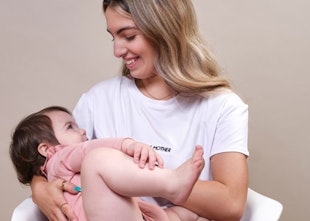FFHQ's Pregnancy Expert and midwife Avril Flynn reveals the best ways to care for your newborn's skin from bathtime to nappy changing.
If you have ever held a recently born baby, you will be aware that there is nothing that feels quite like their velvety soft skin. It is so smooth and beautiful, that it barely seems real! But as well as being very soft to the touch, it needs extra special care too.
How to care for your newborn's skin:
-
Skin-to-skin.
Your baby has been in a fluid filled environment for the entire pregnancy. When they are born, they are suddenly in the air – a huge change of environment. It takes some time for them, and their delicate skin, to adjust.
While babies are in the womb, they are covered with a white sticky substance called vernix. You might notice this when they are born, especially if they arrive a little bit before their estimated due date.
This helps to moisturise their skin, so there is no need to clean it off. When your baby is born, the first thing you can do to help their skin adjust is to do plenty of skin-to-skin contact. This can be done with either parent. It helps to colonise their skin with the natural flora that will help to protect it as they adjust to life outside and grow. -
Don’t over bathe
The general rule is to keep it simple for the first 6 weeks after your baby is born. By this I mean when you bathe your baby, just use warm water and cotton wool and keep the bath times short - this will help their skin not to become over-sensitive or dry. Bathing your baby 1-2 times a week is plenty.
If you do introduce any bath products make sure they are hypoallergenic, dermatologically safe and designed for newborns. Babies do not sweat like we do so need to be washed a lot less. If you bathe them too often, you will wash away all of the healthy flora that is on their beautiful skin from doing skin-to-skin contact with you.![Baby Has Arrived: How To Care For Your Newborn]()
-
Nappies
Change your baby’s nappy often and keep an eye out for any redness or signs of nappy rash. Use a nappy cream to protect their bums. It is also important that they have “nappy-free” time daily.
While this can be a little messy, it’s important that their skin is exposed to the air to help prevent any nappy rash or soreness. Make sure that you are using cotton wool and water or a good quality baby wipe that is suitable for newborn skin. -
Dry skin
As your baby adjusts to its new environment, it is very common for them to have slightly dry skin, particularly if they arrived well past their due date.
From 6 weeks you can use an emollient cream or baby safe moisturiser to help with any dry skin spots. Baby massage has lots of benefits and it can help by using safe baby oils to keep the skin supple and soft. -
Newborn Acne
A common concern for parents is when they notice spots on their baby’s face (and sometimes body). Your baby is exposed to lots of different hormones while in the womb, and like when they will go through puberty, it’s possible that they can have newborn acne. This doesn’t need any treatment and will resolve by itself after a few weeks.
If you notice any rashes or spots at any stage with your new baby, then don’t hesitate to get them checked out by your GP or public health nurse. The vast majority of the time it is nothing to be worried about but as I always say listen to your own instinct, and if concerned seek medical advice. More than anything, don’t forget to enjoy those precious cuddles and touching that perfectly soft magic new skin!
Further information:
https://www2.hse.ie/wellbeing/child-health/caring-for-your-babys-skin.html











